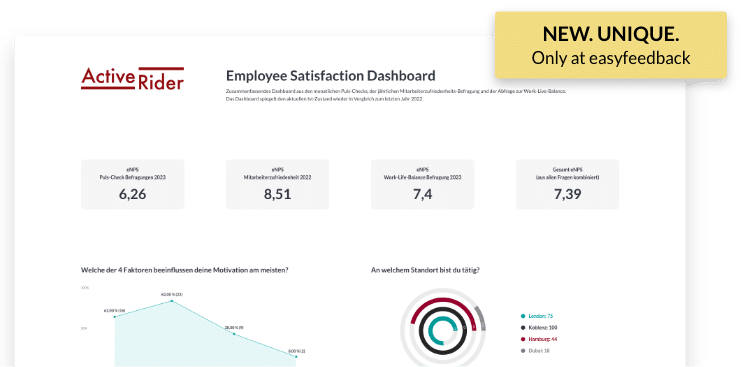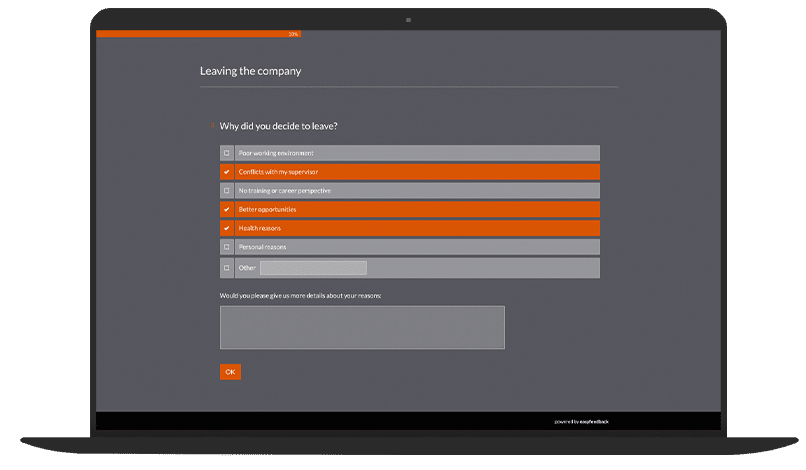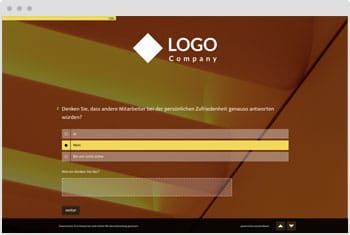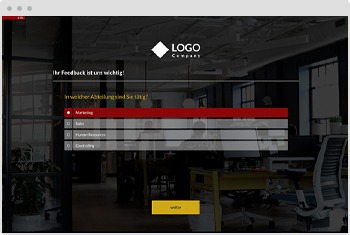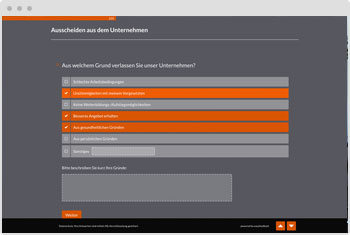Reduce fluctuation in a targeted way with exit interviews

With this ready-to-use survey template, you can ask the reasons why employees leave your company. This enables you to initiate measures to reduce the fluctuation rate in the long term.

“Identifying customer needs is an essential part of our business. easyfeedback accompanies us for many years as a loyal partner in this task. We particularly appreciate the intuitive usability of the survey tool as well as the professional support.”
Franziska Becker
Guild Lead User Experience Research

“We use easyfeedback for internal and external surveys – fast, comfortable and really easy! Straightforward and cordial support can always create a smile. We really appreciate the permanent development of the platform.”
Jennifer Fischer
Guest & Competitor Insights Analyst
Content and targets of this exit interview template
Why should you have an exit interview? The answer is simple: every termination leaves a gap. Knowledge and skills leave the company along with the person.
The replacement must first be found, hired and trained. The transition period often burdens direct colleagues with significant extra work. As a result, errors and bottlenecks can occur.
Find out specifically why employees leave with an employee survey. Collect information from a regular and standardized exit interview via questionnaire. Based on this information, you can take action and reduce turnover.
Content:
• Demographic data and length of service information.
• Determining the reason for termination
• Feedback on work climate
• Feedback on workplace / workload
• Willingness to recommend to others
Targets:
• General view of employees
• Identify undesirable developments through exit interviews
• Introduce fluctuation-reducing measures at an early stage to prevent problems from occurring
• Continuous corporate development
• Modern personnel management

Data privacy protection „made in Germany“ (GDPR)

Anonymity functions for open feedback
Almost everything you need to know about exit interviews
1. What is an exit interview? And why is it important?
An exit interview is a final discussion with an employee who is leaving the company.
The aim of the interview is to find out the reason for the employee’s decision. Because only if you know the reason for your employee’s unexpected resignation can you identify potential problems and take action if necessary. In this way, you prevent further terminations for the same reason and save high financial expenses for the search and training of new employees.
With exit interviews, you have a valuable tool to promote staff development and retention. In addition, you get another chance to receive valuable feedback from departing employees. This gives you the opportunity to sustainably improve the working atmosphere and employee satisfaction.
In summary, the exit interview is a method of the offboarding process and thus just as important a strategic instrument of the employee cycle as the interview of potential new employees.
2. What are the advantages of an exit interview?
If an employee decides to leave the company, there is literally “nothing more at stake” for them. For you, this offers the opportunity to receive honest feedback.
You should take advantage of this opportunity, because if you don’t, a lot of valuable information will leave the company along with the employee’s know-how.
Among other things, an exit interview enables you to identify potential problems in personnel management and to rectify them. In this way, you reduce fluctuation within the company and improve the working atmosphere.
An open discussion at eye level also makes your employees feel heard and taken seriously. In this way, you can strengthen employee loyalty even after termination and benefit from positive word-of-mouth advertising.
Employer ratings and recommendations can have a positive impact on your attractiveness as an employer.
3. What could the process of an exit interview look like?
It makes sense to firmly integrate the exit survey into the offboarding process. It’s best to keep the defined process in writing, so you don’t have to redefine it each time. To make it a little easier for you, we have compiled the most important steps in a flow chart:
1. Select a neutral person for the interview
Select a neutral person for the exit interview. For example, a colleague from the HR department with whom the departing employee has a neutral relationship is a good choice here. The supervisor should not lead the conversation under any circumstances, as honest feedback cannot be expected in this case.
2. Arrange an appointment for the exit interview
The last working day is usually already relatively full for the departing employee due to the handover to colleagues and various organizational matters. Therefore, if possible, another day should be chosen for the interview. Generally, a date within the last working week is a good choice. You should also take into account any remaining vacation entitlement.
3. Set place for the interview
Determine the location for the interview. Make sure that the place allows a confidential atmosphere and that you will not be disturbed. Choose a neutral meeting room rather than your own office. A round table is particularly suitable, as this avoids a face-to-face situation. Furthermore, it is also an option to let the survey take place virtually, for example via a prepared online questionnaire.
4. Draw up an agenda
Think about an agenda for the meeting in advance. What topics should be discussed, what questions do you want to ask? So that the departing employee can also prepare for the interview, you should make the agenda available to him or her before the appointment.
5. Send invitation
Use the invitation to once again record the most important data about the appointment. This includes the place, date and agenda for the meeting. The person conducting the interview should also be mentioned by name. In addition, the contact details for possible queries should also be included.
6. Conduct exit interview
Guide your interviewer through the interview using the prepared agenda. Listen and try to put yourself in the person’s shoes. Contribute to a comfortable interview environment by letting your interviewee finish and not engaging in argument. Take notes during the conversation.
7. Analysis and evaluation of the exit interview
The information you gathered in the exit interview or through the interview you conducted is the basis for your analysis. This is where the use of software can be helpful. Compare different conversations with each other and filter out commonalities.
4. What framework conditions must be observed during an exit interview?
Create a pleasant atmosphere for the interview. The best way to do this is to schedule enough time for the interview and give your interviewer your full attention. Your employee is unlikely to open up in a door-to-door conversation.
Keep the conversation from an exit interview confidential and communicate this to your interviewer. Have a one-on-one conversation; the more people present, the more likely pressure will build and your chances of getting honest feedback will decrease.
It also makes sense to hand out the questionnaire to your employee when you invite them. This gives him the opportunity to prepare and answer the questions in peace. This enables you to go into the answers in greater depth during the interview and increases the chance that the employee will agree to the interview. After all, exit interviews should always be voluntary.
Give your employee the choice and accept his or her decision if he or she decides against it.
5. When should you conduct an exit interview?
It is advisable to hold an exit interview only shortly before the employee leaves. If you schedule the meeting too early, there is a risk that the employee will not provide honest feedback for fear of possible consequences. At best, all framework conditions have already been clarified at this point and the employee has already received his or her reference at best.
6. Who should be present at an exit interview?
As an interview partner for the departing employee, select a person with whom the employee has a good or neutral relationship. A person from the HR department or another trusted person from the company is suitable for this.
The direct superior should be avoided as a discussion partner, since the reason for the termination may be directly or indirectly related to the superior. In this power relationship, especially if the employee still has to work under the supervisor for some time, honest feedback is more likely not to be forthcoming.
It is best to conduct the exit interview as a one-on-one meeting; this increases the chance of obtaining useful information and an open exchange.
7. What kind of topics can be addressed during an exit interview?
Since an exit interview is a sensitive topic, a frequently asked question is: What questions am I allowed to ask at all and what is better not to address?
We have therefore compiled a list of potential questions for you. Here, the reason for termination is the main focus, but you can still use the opportunity to gain insight into other areas that are relevant to employee satisfaction. Here are our suggestions:
- What was the reason for your resignation?
- What were you missing in order to stay?
- How did you feel about the atmosphere in the team/company?
- How was your relationship with your supervisor?
- Did you feel the distribution of work in the team was fair?
- Were you able to express criticism openly? How was it dealt with?
- Did you have the opportunity for further training? Opportunities for promotion?
- How did you feel about the work-life balance?
- Would you recommend applying for a job with us to a friend? Why or why not?
- What advice would you give us to retain employees?
8. What questions can I ask the employee in an exit interview?
The aim of the exit interview is to find out the reason for the termination and to derive possible measures from this.
If you want to use a questionnaire for your exit interview, limit yourself to a few selected questions and address the answers in a direct conversation. This way you will learn more than if you let your employee answer a catalog of questions without talking to him directly.
Possible questions for your exit interview questionnaire could be:
- How satisfied were you with your duties?
- Were there enough opportunities for advancement?
- What was the workload like?
- How was the atmosphere in the team?
How was your relationship with supervisors? - Were you able to identify with the company?
- What would have had to change for you to stay?
- Were you satisfied with your salary?
- If you could change something in our company: What would it be?
You can find more possible questions in our exit interview questionnaire template.
Another tip:
Talk to your employee not only about the reasons for quitting, but also about what the employee liked best about his or her job. That way, you’ll find out what’s already going well and what you can build on.
9. What can I learn from the exit interview questionnaire?
You can gain a variety of insights from an exit interview. Not only will you learn the reason for the departing employee’s resignation, but by evaluating the results and comparing the answers from previous exit interviews, you can also uncover possible deficits.
If the same reasons for quitting are often given, such as lack of career opportunities, excessive workload, problems with the supervisor, you can target these points.
Use the opportunity of an exit interview and do not waste the potential to increase employee loyalty and reduce employee turnover through feedback.
10. What should I avoid in an exit interview?
Conducting an exit interview is not always easy; after all, there are reasons for the termination. To ensure that your conversation is a complete success, we have compiled a few no-go’s for the exit interview below:
Participation of the supervisor
The supervisor has no place in an exit interview. This is because an honest answer from the employee can hardly be expected if the boss is present. For your exit interview to be successful, it needs a neutral interlocutor, for example from the HR department.
Confidentiality is not maintained
Create a confidential atmosphere and conduct the exit interview in private as much as possible. Avoid reporting criticism voiced in the interview to the supervisor or elsewhere in the company. If it becomes known that confidential information is making the rounds after the interview, you cannot expect honest answers from your employees in the future. If similar criticisms are made more frequently, the supervisor can be approached about the criticism without mentioning the names.
No time for the exit conversation
Due to a lack of time, exit interviews are cancelled or combined with other offboarding processes. Thus, some companies come up with the idea of combining the exit meeting with the termination meeting or even with the handover meeting with colleagues and superiors. What initially looks like a great idea for saving time is, however, rather counterproductive in practice, because the confidential, open character suffers as a result.
Conversations “between door and door” should also be avoided. Allow sufficient time and schedule the appointment firmly in your calendar. Avoid interruptions by phone calls or colleagues.
Let’s get ready to rumble
The exit interview is not the place for a slap fight or final settlement. Stay factual and try to put yourself in the employee’s shoes. Remember, the point is to find out more about the employee’s experience. But be careful not to make it seem like an interrogation. Empathy is what’s needed here. Because that’s the only way you’ll get valuable information and leave a positive impression.
11. How to evaluate the exit interview questionnaire correctly?
When evaluating the information obtained, the focus should always be on the objective of the survey, namely to uncover weaknesses and derive measures for employee retention. In this respect, attention should be paid to whether there are recurring reasons for terminations or whether there are correlations between company conditions and terminations.
It can also be interesting to find out whether there are more terminations in certain areas of the company or whether certain groups of employees are affected more frequently than others. For example, age or gender may play a role here. Focus on deriving measures that could have avoided the termination.
For a better overview of the results, it is a good idea to create lists and compile the reasons for termination that are mentioned several times. In this way, you can evaluate the percentage of each reason and, for example, derive valuable insights for the areas of career development, management style, workplace organization and corporate culture.
After the evaluation, it also makes sense to communicate the results to those responsible. If, for example, a supervisor’s management style is repeatedly criticized, this should be openly communicated. If, on the other hand, the equipment of the workplace is criticized, a concept could be developed with the responsible departments to improve the technical and/or organizational equipment of the workplaces.
Management should also be regularly informed about the results of exit interviews and the lessons learned.
You are in professional company






easyfeedback welcomes more than 740.000 participants per month!
